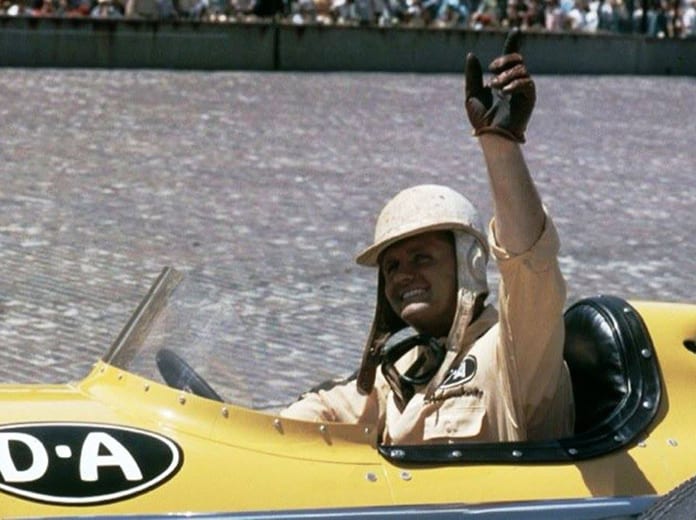The tragic death of Bill Vukovich during the 1955 Indianapolis 500 unfairly cast a long, dark shadow over the career of the winner of that year’s race — Bob Sweikert.
Despite being one of America’s most talented drivers, Sweikert is most often remembered for winning the 500 that Vukovich should have, could have and would have won.
Sweikert was not the first Indianapolis winner to have collected victory at another’s expense. And it should be noted that he’d raced himself into second place, behind Vukovich, prior to Vukovich’s fatal crash on lap 57.
We’ll never know if Sweikert could’ve caught and passed ‘Vuky,’ but we do know he had already proven himself as worthy in his climb to the top echelon of the sport.
Born in Los Angeles on May 20, 1926, Sweikert moved to Hayward, Calif., with his parents in 1942. There Sweikert transformed his long fascination with cars into involvement.
He was a natural mechanic and at just 16, he found work in a Ford dealership. With his earnings, he bought an old Ford coupe, modified it and regularly beat his friends in street races, among them another future race car driver, Ed Elisian.
Fresh out of Hayward High, Sweikert opened his own shop, Sweikert Automotive, and built a track roadster that he raced for the first time at Oakland Speedway. He finished an impressive second.
He progressed quickly from roadsters to midgets with the Bay Cities Racing Ass’n, claiming the organization’s indoor midget championship in 1949. That same year, Sweikert strapped into a sprint car for the first time and excelled.
That success turned his thoughts toward AAA’s prestigious Midwest sprint car circuit and, perhaps, Indianapolis. AAA California Zone Supervisor Gordon Betz thought Sweikert was capable and scribbled across his driver’s certification, “The greatest 500 prospect from California since Freddie Agabashian.”
Sweikert set about to prove Betz correct, attacking the infamous “Hills” — the trio of blindingly fast, high-banked tracks, Dayton Speedway, Winchester Speedway and Salem Speedway. These tracks were so dangerous some drivers refused to race on them.
Sweikert thrived on them.
His prowess eventually earned him a championship, induction into the Knoxville Sprint Car Hall of Fame and, more immediately, an Indianapolis offer.
The “Hills” were where Indianapolis car owners went looking for prospects and many liked what they saw in Sweikert. Barely in the Midwest two months, he got a shot at the speedway.
The car wasn’t much, only quick enough to get him through his rookie test and nothing more. His 1951 car wasn’t much better. He qualified, but was bumped. Putting aside concerns that he’d never meet his own and other’s expectations, Sweikert finally made the race in 1952. He barely squeezed in, 32nd spot, and his race was short-lived. But that mattered little, he was an Indianapolis veteran.
With that his career took off. Sweikert began winning routinely in sprint cars. He joined the Dean Van Lines team for the 1953 Indianapolis 500 and in September he won what is still considered one of the best races of all time — the inaugural Hoosier Hundred where the top-four finishers raced nose to tail, wheel to wheel, under the checkered flag.
For 1955, Sweikert landed with the crack John Zink team and its young mechanic/builder, destined to become an icon — A.J. Watson. He qualified the pink-and-white roadster solidly, but only days before the race Watson was called home to California because of a medical emergency involving his pregnant wife.
That could’ve proven disastrous. But Sweikert helped the crew finish preparing the car and rebuilt the Offy engine himself. It never missed a beat in his dramatic Indianapolis 500 win.
As well as Indianapolis, Sweikert went on to claim the national championship and the Midwest sprint car title. It was the only time in history a driver has accomplished this impressive triumvirate.
The next season loomed brighter for the handsome 30-year-old. He joined the D-A Lubricants Championship team and attempted to repeat his sprint car championship with a car he owned and maintained. He was honored with his photo on the cover of Sports Illustrated and was considering inquiries from Europe to drive Formula One.
Then came a June 17 sprint car race at Salem Speedway. Racing close with Elisian, both cars pushed high. Sweikert’s car, on the outside, brushed a piece of metal extending from the wall and flipped violently out of the track.
Sweikert died instantly. A life, with promise yet unfulfilled, gone.
